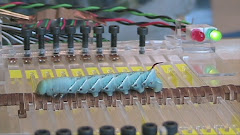I started another day with fried rice and beans plus scramble eggs and cheese. Just when I got to my second coffee around 7:30am the bus brought in all the park rangers in for breakfast. People streamed into the Comidor with greetings and jokes. I watched them eat and talk and set out to work with a mouthful of Costa Rican rice coffee aroma. Somewhere in my heart, I envied such life: so simple, so natural and communal.
 It’s time to organize data and find out what and what else can I get out of this trip. I started up with three aspects: Biometry, Kinematics, and Behavior. The biometry project was targeted to compare the biometry proportions of different caterpillar species as well as tracking down the ontogenetic scaling of some species. The only way to perform measurements on soft-bodied animal is to use photography. Unfortunately, caterpillars are wild animals after all. There is no easy way to get them to sit still in a specific posture while I photograph. Weighing them is also impractical because many of them do not relinquish their substrate (often their food as well). Brute force can injure caterpillars and decrease their survival rate dramatically, making ontogenetic tracking impossible. However, the general biometry can be still obtained from the video frames I collect in the kinematics project. One of the measurements I was looking for is the aspect ratio of the cylindrical body. Compare the two caterpillars before and after this paragraph to see what I mean.
It’s time to organize data and find out what and what else can I get out of this trip. I started up with three aspects: Biometry, Kinematics, and Behavior. The biometry project was targeted to compare the biometry proportions of different caterpillar species as well as tracking down the ontogenetic scaling of some species. The only way to perform measurements on soft-bodied animal is to use photography. Unfortunately, caterpillars are wild animals after all. There is no easy way to get them to sit still in a specific posture while I photograph. Weighing them is also impractical because many of them do not relinquish their substrate (often their food as well). Brute force can injure caterpillars and decrease their survival rate dramatically, making ontogenetic tracking impossible. However, the general biometry can be still obtained from the video frames I collect in the kinematics project. One of the measurements I was looking for is the aspect ratio of the cylindrical body. Compare the two caterpillars before and after this paragraph to see what I mean.
6/5
In a forest full of activities, it is very difficult to stay put for more than a day. Although I haven’t finished the image organization on my two EEE PCs, I decide to head out to the field anyways. As the sun journeyed pass 10am, the wet “dry forest” turned into a steamer. I could smell many things around me, from fresh leaves to fermentation in the rotten woods. The strongest of all was a pungent smell that reminded me of steamed peanuts. I never figured out what that was, but it definitely imprinted in my memory of Santa Rosa. Anyways, the most memorable discovery from today’s field work was a leaf craftily “eaten” into a beautiful symmetric pattern. I couldn’t help but respect the "minds" of these wild caterpillars.

Over time, I found myself very tuned in to looking for caterpillars. I could distinguish leaves damaged by caterpillars from those eaten by ants or beetles. I was able to spot the caterpillar feces and trace the source to a plant, and I became pretty picky about what caterpillar I get. One of the tasks for today’s field work was to collect some cydista plants for my Manduca lanuginose. This was the only Manduca I found so far so I really should keep them alive. Just as I was full with plastic bags of caterpillar and plant harvest, something lighted up my eyes. It was a huge Manduca sexta gorging up a Solanum hayesii. I was very excited to see such a familiar body even though my memory of Manduca has been this obstinate stupid animal in the lab. For some reason, the wild type looked much brighter in color. It’s got a puffy body with clear healthy white lateral strips. Maybe the organic food really made a difference.
6/6
The English speaking researchers tend to cluster in one table at dinner, although many of them speak perfect Spanish. I have been meaning to learn to speak a few words, but the data organization work every night really crushed my ambition. Over some rice and beans with pork stomach, we talked about what we encountered during the day and frustration with the animals. Indeed, field work is a very different mode of research. We are studying the organisms in the great nature which is beyond our power to control. We cannot force any activities or interactions. We must let them come to us. Patience is the key and letting things be is the attitude.
Due to my field work during the day, I started to shift my caterpillar photography work to after dinner. Tonight, I found a keystone to solving the gait transition mystery in caterpillars. So far I’ve found caterpillars that inch with reduced prolegs and caterpillar that crawl with full prolegs. This caterpillar I picked up today inches with full prolegs, displaying how exactly a inching gait can be derived from a crawling pattern. This spotted caterpillar had a full set of functional prolegs from abdominent 3rd. However, when it picked up speed to run away from me, it lifted very large proportion of its body and actually cut under itself to gain the maximum step length. The whole gait pattern resembled a very conservative inching which can be shifted into a crawl at any moment in a cycle.


.jpg)
No comments:
Post a Comment